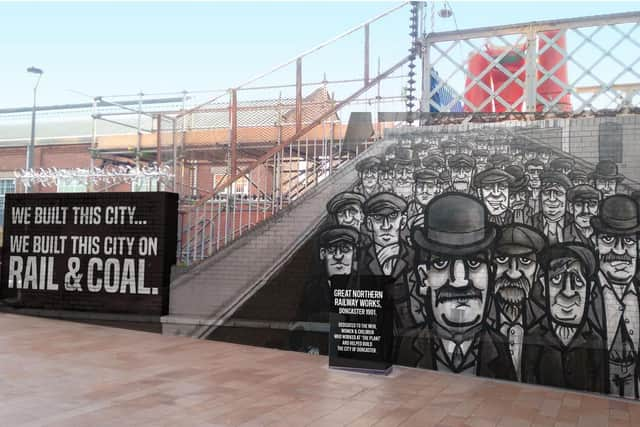Artist's mural plea to pay tribute to Doncaster's coal and rail workers
and live on Freeview channel 276
Artist Nick Boruk, who works under the name We Are Blok Heds, has revealed that he would like to create an artwork near to Doncaster railway station to workers who were employed at the Plant where the famous Flying Scotsman and Mallard locomotives were constructed.
He wants to create the mural at the end of a bridge leading from the Plant to the city centre which is scheduled for demolition.
Advertisement
Hide AdAdvertisement
Hide AdSharing an impression of the work on social media under the heading “we built this city on rail and coal,” he said: “I hear the Plant bridge is to be taken down.


“If the wall stays, I'd love to paint this mural dedicated to the people who worked at the Plant and helped build Doncaster into the city it is today.
“If any of the top brass out there at LNER or Doncaster Council see this post, please contact me if you want to make it happen.”
In 2022, Network Rail unveiled plans to remove the historic footbridge once used by thousands of Doncaster railway workers.
Advertisement
Hide AdAdvertisement
Hide AdAn application was submitted to Doncaster Council for permission to dismantle around half of the Victorian bridge, which links Doncaster Station to Denison House – once the offices of the Plant Works – and crosses the East Coast Main Line.
It was once the main access point for the Plant’s workforce from the town centre, but nowadays is not open to the general public and its condition has deteriorated to unsafe levels.
Although the structure is not protected in itself, it forms part of the wider Grade II-listed Plant Works complex. Network Rail will also consider replacing the section between Platform 5 and Denison House to retain the connection.
The bridge was built in the 1870s but moved in the 1950s to accommodate electric cables, and has had some alterations during its life. Some original features, such as ornate columns, may be retained though the bridge has been described as ‘weak’ and ‘life expired’ and posing a safety risk.
Advertisement
Hide AdAdvertisement
Hide AdIn the application, the council states that is it keen for the historic link to be partially retained to encourage the future occupancy of Denison House, which is now let as office space.
The Great Northern Railway established its Doncaster workshops in 1853, and famous engines such as the Mallard and Flying Scotsman were built there.
After the war, its function began to change as steam locomotive production ended and carriage building also stopped. It became a diesel repair shop, and some buildings were eventually demolished.
One of the railwaymen who would have used the bridge in its heyday was Sir Nigel Gresley, the GNR’s chief mechanical engineer who designed Mallard and Flying Scotsman. He moved his family to the Thorne Road area of Doncaster in 1905 and would have commuted to his offices via the bridge.
At its peak, the Plant was Doncaster’s largest employer and had three medical centres, two dining halls that could seat 450 workers, and a staff sports club with over 1,700 members.